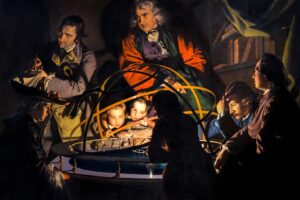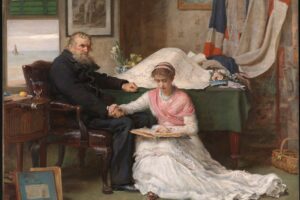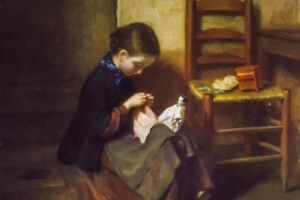Jacques-Louis David, 1784
A Moment That Changed Art—and History
Painted in 1784 by French artist Jacques-Louis David, The Oath of the Horatii is one of the most powerful images in Western art. It doesn’t just tell a story—it delivers a message. Standing before this painting feels like watching a moment of history, theater, and deep human emotion, all at once.
The Ancient Roman Legend Behind the Painting
The story comes from ancient Rome. Two cities, Rome and Alba Longa, were at war. To avoid a full battle, each city chose three champions to fight in their name. Rome chose the Horatii brothers. Alba chose the Curiatii.
But here’s where the story becomes personal: the families were connected by love. One of the Horatii sisters was married to a man from the Curiatii. One of the Horatii brothers was engaged to a woman from Alba. A battle between cities became a battle between family. It was a tragic setup—honor and loyalty to Rome on one side, and love and personal ties on the other.
A Painting Full of Meaning
In the painting, David captures the moment the three Horatii brothers swear an oath to their father. Their arms are raised high, firm and determined. Their father holds three swords, presenting them as symbols of duty. The light falls on them like a spotlight, highlighting their strength and resolve.
To the right, the women sit in sorrow. They are mothers, sisters, and wives. Their bodies bend with grief. Unlike the men, who stand tall and straight, the women’s forms are curved and soft, overwhelmed by what’s about to happen. They know what’s at stake—not just glory, but loss.
This contrast is what makes the painting so moving. It shows both sides of sacrifice: the courage to fight, and the pain of those left behind.
A Message for the French Revolution
When David painted this, France was on the edge of great change. People were questioning their leaders. Ideas of duty, freedom, and sacrifice were rising. This painting was more than a story from Rome—it was a message to France.
David was calling for bravery and honor, just like the Horatii. He believed in standing up for what was right, even when it came with great cost. This made the painting a symbol of the Neoclassical style, which turned to the past for strength and guidance.
The Power of Simplicity and Structure
Every detail in the painting is carefully chosen. The background is simple, like a stage. The figures are placed with balance and purpose. The colors are clear and bold—red, white, black, and stone gray. It’s not crowded with decoration. Instead, the drama comes from the emotion and the message.
Why The Oath of the Horatii Still Matters
This painting isn’t just about ancient Rome. It’s about choices we all face—duty versus desire, honor versus heart. It reminds us that strength isn’t always loud. Sometimes it’s found in quiet promises and painful decisions.
Jacques-Louis David gave us more than a beautiful image. He gave us a story about courage, sacrifice, and the power of standing together for something greater than ourselves.
About Artist

Jacques-Louis David (1748–1825) was a French painter who became the leading figure of Neoclassicism, a movement that rejected the frivolity of the Rococo and sought to revive the moral and aesthetic values of ancient Greece and Rome. His art was not just beautiful; it was a powerful tool for political and social change. David’s work defined a new style that was severe, intellectual, and deeply political, making him a central figure in the French Revolution and later, the court of Napoleon Bonaparte.
Artistic Style and Legacy
David’s style is characterized by a dramatic shift from the soft, sensual curves of Rococo to the sharp lines and moral clarity of Neoclassicism. His paintings are known for:
- Classical Themes and Heroes: He drew heavily from ancient history and mythology to tell stories of virtue, civic duty, and self-sacrifice.
- Sharp, Defined Lines: He rejected the loose brushwork of the Rococo in favor of crisp, sculptural forms that give his figures a sense of heroic grandeur.
- Moral and Political Messages: His art often served as propaganda, urging viewers to embrace patriotism and civic virtue.
- Controlled Lighting: He used strong, raking light to emphasize form and clarity, avoiding the dramatic tenebrism of the Baroque.
Artwork Profile
Here paintings represent the full range of his career, from his early Neoclassical masterpieces to his later works for Napoleon.
- Belisarius Begging for Alms (1781): An early Neoclassical work that depicts the Roman general Belisarius, unjustly fallen into disgrace, begging for money. It’s a clear moral statement about the cruelty of the state.
- The Lictors Bring to Brutus the Bodies of His Sons (1789): A powerful and stark depiction of a Roman leader who chose civic duty over personal love. This painting, with its clear composition and somber tone, was seen as a call for revolutionary sacrifice.
- The Farewell of Telemachus and Eucharis (1782): A more sentimental and intimate work from his early career, it depicts a scene from a classical novel, showing his softer side before his full turn to political subjects.
- The Death of Socrates (1787): One of his most famous masterpieces. It portrays the Greek philosopher Socrates as a moral hero calmly facing death. The painting’s noble composition and stoic emotion made it an icon of Enlightenment ideals.
- The Anger of Achilles (1819): This late painting, from his exile in Brussels, shows David returning to classical subjects with a more refined and emotionally charged style.
- Oath of the Horatii (1784): Arguably his most famous work and a manifesto of Neoclassicism. It depicts three Roman brothers swearing an oath to their father, prioritizing duty to Rome over family. Its stark, geometric composition and powerful moral theme made it an instant sensation.
- Napoleon Crossing the Alps (1801): A famous equestrian portrait of Napoleon as a heroic figure. The painting is a work of political propaganda, portraying Napoleon as a dynamic and determined leader.
- The Emperor Napoleon in His Study at the Tuileries (1812): A more intimate portrait of Napoleon, but one that still emphasizes his power and intellectual prowess. It shows the emperor standing in his study late at night, a subtle nod to his tireless work ethic.



